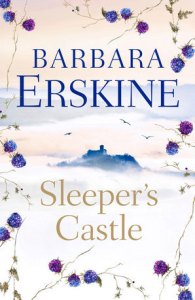 I’m finding that I usually like the sound of Barbara Erskine’s books much more than I like the books themselves! I thought Sleeper’s Castle was an enjoyable read, but I’ve had very mixed feelings about the others that I’ve tried, even Lady of Hay, which I’d heard so much about. Still, when I saw her latest novel, The Ghost Tree, in the library, I couldn’t resist picking it up.
I’m finding that I usually like the sound of Barbara Erskine’s books much more than I like the books themselves! I thought Sleeper’s Castle was an enjoyable read, but I’ve had very mixed feelings about the others that I’ve tried, even Lady of Hay, which I’d heard so much about. Still, when I saw her latest novel, The Ghost Tree, in the library, I couldn’t resist picking it up.
Like most of Erskine’s other books, this one is set in two time periods and includes elements of the supernatural which link them together. In the present day we meet Ruth Dunbar whose father has just died, leaving her his house in Edinburgh. On arriving at the house, she is surprised to find that it is already occupied by a stranger who tells her his name is Timothy and that he has been caring for her father during his final months. According to Timothy, it is actually he and not Ruth who will inherit the house – and although Ruth’s lawyer assures her this is not the case, it seems that Timothy is not prepared to give up his claim.
As she begins to sort through her parents’ possessions, Ruth finds a collection of old diaries and letters written in the 18th century by Thomas Erskine, an illustrious ancestor of her mother’s. Thomas led an eventful, dramatic life and Ruth quickly becomes captivated by his story, but when she starts to think she can see Thomas standing beside her as she reads, the boundary between past and present seems to have been broken.
The Ghost Tree, as the title would suggest and as I have hinted above, is a ghost story, so I am counting it towards the R.I.P. XIII challenge. Thomas himself, as Ruth’s many times-great-grandfather, is no threat to Ruth, but he is not the only ghost who finds his way into the 21st century – there is another, who is a much more menacing and evil presence. Ruth (as seems to be a standard requirement of a Barbara Erskine heroine) just happens to have several friends and acquaintances who are experts in the paranormal and she enlists their help in dealing with her ghostly visitors. As far as ghost stories go, I didn’t find it either particularly scary or very atmospheric, but if you enjoy reading about séances, exorcisms and other aspects of the supernatural, you will probably find a lot to interest you here.
The narrative switches between past and present throughout the novel and as usual it was the historical one that I found most compelling. Thomas Erskine is a real life ancestor of Barbara Erskine’s and she has based his story on what we already know about him and on her own research into his life. Born in Edinburgh in 1750, he served in the Navy in the Caribbean and later joined the army, before returning to Britain to concentrate on a career in politics and the law. You can easily find a wealth of information about him online if you’re interested in knowing more, but if you’re thinking about reading The Ghost Tree you might prefer to read the novel first before looking up all the facts. Personally, I think there would have been enough material for a whole book just about Thomas and his adventures, without needing to involve ghosts or anything else!
I had other problems with the modern day sections of the book. For a start, the villains (one of whom is Timothy, the man contesting Ruth’s inheritance) are stereotypical and lack the sort of nuance and depth I prefer – and I quickly lost patience with the way Ruth and her friends repeatedly put themselves at risk, despite knowing how dangerous the villains were. There’s also an unpleasant storyline involving some cases of ghostly rape, which added very little apart from shock value.
This book was a bit of a disappointment, especially after enjoying Sleeper’s Castle so much, but at least I found Thomas Erskine’s story interesting, so I didn’t feel that it had been a waste of time. I just wish we could have spent more time with Thomas and less with Ruth and the ghost hunters! Can any Barbara Erskine fans tell me whether there are any of her earlier books that I might enjoy more, particularly any that spend a more substantial amount of time in the past or that use the supernatural elements more convincingly?
This is my fourth book read for the R.I.P. XIII challenge (category: supernatural).







